
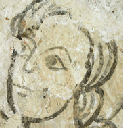
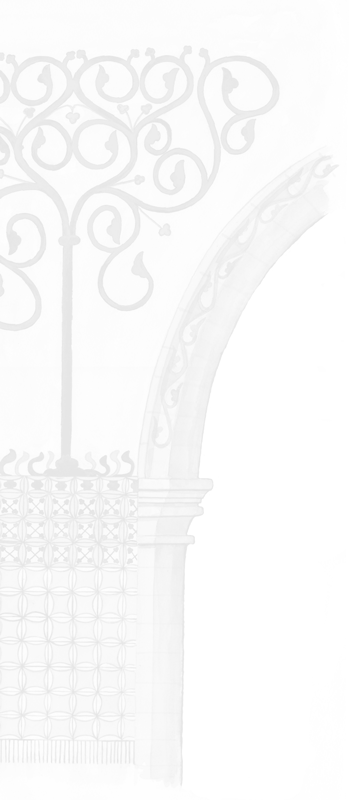
The earliest identified paint scheme, dated to circa 1220, is also one of the best preserved. So much of these paintings survives that it is possible to reconstruct the entire scheme for the north side of the Nave for this period. Exactly why this particular scheme has survived so well may be due to a number of factors. Firstly, the scheme was whitewashed over within a century and a half of being completed, with subsequent protective layers of lime-wash being added as the centuries progressed. Secondly, this first scheme was painted directly onto relatively fresh plaster and it may well be that a natural frescoing effect was accidentally produced.
The scheme itself stretches along the length of the three eastern most arches of the north arcade and consists of three distinct elements. The first element is a series of angels painted high up in the arcade spandrels. In each of the main spandrels two angels sit facing each other on cushioned benches, their hands raised in debate and their wings stretching out behind them. Below each pair, in the base of each spandrel, another angel stares out into the church.
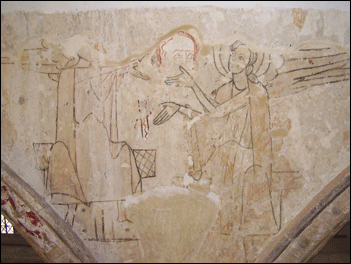
Left: a section of the Angel scheme near completion of the conservation programme. The distinctive hand gestures are found in a number of contemporary manuscripts and it has been suggested represent a stylised debate going on. The head that appears between the two figures is from the third scheme and has tentatively been identified as Saint Paul.
Right. A close up of the face of an angel.
At the western end of this scheme sits a further angel. Although similar to the other angels this figure does show a number of telling differences. In the first instance, and most strikingly, the colours of the angels robes are far brighter than those of his neighbours. In addition, instead of facing into the centre of the arch, this angel faces outwards, with his wings pointing downwards. It appears likely that this figure marked the western extremity of this scheme and, before the mid-thirteenth century extension of the church, sat at the very western end of the nave. The figure would have been covered over by the second scheme only 30 or 40 years after being painted, which may explain the wonderful preservation of the original colours.

Left: the angel at the western end of the first scheme. The western wall of the early church was located just to the left of the angels wing. This meant that her wing, unlike all the other angels, had to be painted pointing downwards. The presence of the other smaller figures nearby, all from a scheme dated to at least a century later, has led to this area often being mistaken for an Annunciation scheme.The colours of the cloak in particular are far better preserved than on the other angels, largely due to the fact that it was covered over by subsequent paint schemes only a few decades after being first painted.
Right: The scrollwork pattern begins to emerge during the cleaning process. The scroll and dot patterns are believed to be almost identical to those found in the Lady Chapel at Chichester Cathedral - which also dates to the same period.
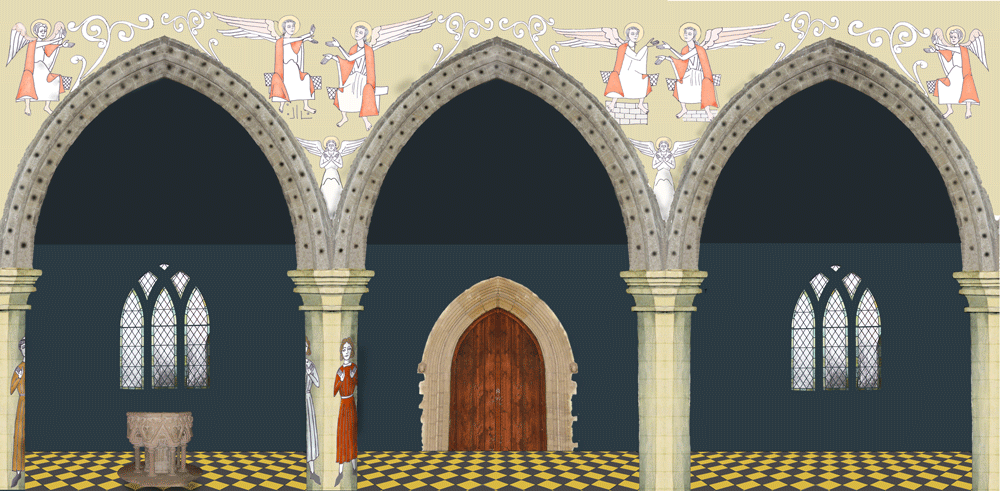
The second element of this first scheme is to be found underneath the actual arches themselves and takes the form of linear scrollwork and dot decoration. This decoration is very similar to that found in the Lady Chapel at Chichester Cathedral, also dated to the same decades of the thirteenth century.
Below this scrollwork, on the actual pillars themselves, is the third, and very unusual, element to this scheme. This takes the form of a number of life sized figures that range around the pillars. Exactly who these figures are meant to represent remains unclear, although the absence of any halo would tend to indicate that they are not meant to represent saints. Most of these figures, painted directly onto the stone, are very faded and the cleaning process actually revealed the presence of a previously unknown figure in the north aisle.

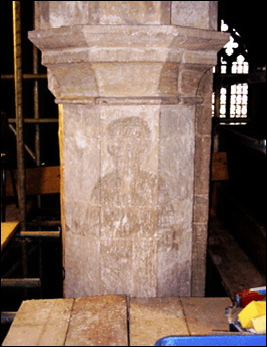
The extent of the preservation of this early scheme is unusually good—making Lakenheath one of the few places in England where it is possible to reconstruct exactly what the inside of the nave must have looked like in the first decades of the thirteenth century. A tentative reconstruction of elements from this scheme are shown below.
Left: one of our ghostly figures emerges from the stone of the a pier in the north arcade. The figures are painted directly on to the stonework and are now very faint.
Right: Although the head is now indistinct, the robe and hands of this figure are clearly visible.

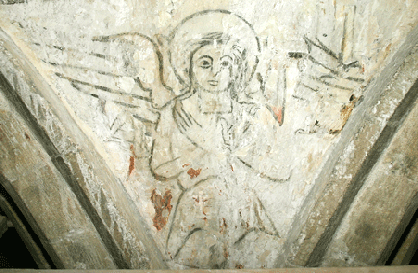
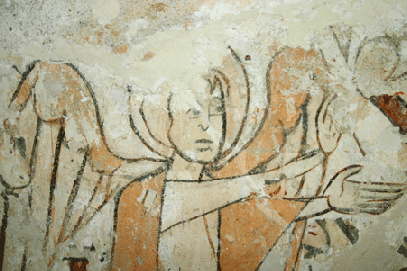

Scroll over to enlarge